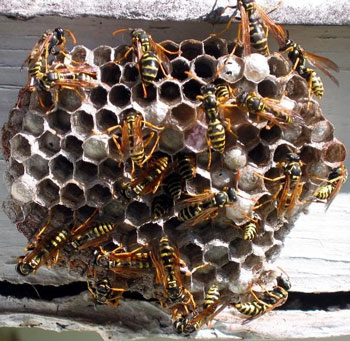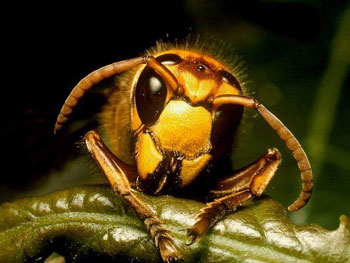

Wasps common in Arizona are the docile mud dibber and the aggressive paper pollsters (umbrella wasps). Pollster wasps are easily identified by their bright yellow color. They are aggressive and will sting with little cause. The most dangerous species of stinging Hymenoptera are wasps of the family Vespidae. A useful characteristic that aids in field identification of the vespid wasps is that they fold their winds lengthwise when at rest, making the wings seem only half as wide as they actually are. They also hold their wings separately, often parallel to the body, when at rest.
These wasps are social insects that build nests of a paper-like material, which are a mixture of wood fibers and the salivary secretions of the female wasp. The nest resembles an inverted umbrella or looks like an upside down bee honey comb. In northern, temperate regions of the world, new colonies must be founded each year, because only the mated queens from the previous year’s colonies overwinter.


Queens are inactive during the winter, hiding in protected niches under tree bark or in stonewalls, attics and other sheltered places. In early spring, overwintering queens- called foundresses, since they establish, or find new nests and colonies each year- visiting exposed wood surfaces. Raw and weathered wooden fences or sidings, dead tree limbs where the bark has sloughed away makes a good nest. They chew away wood fibers and combine them with salivary secretions to form the paper-like carton for nest construction. The nest is begun by the foundress as she builds a small number of cells and places an egg in each. After the eggs hatch, larvae develop within the cells and are completely dependent on the queen for food.
The queen forages outside the nest and brings food back to the larvae, caring for them in the way until pupating occurs. Food for the larvae is protein, usually caterpillars or other insects. Adult wasps feed on liquids such as nectar, honeydew and juices from the bodies of insects fed to larvae. After first sterile female workers emerge, these workers take over nest building and brood rearing, and the queen stays on the nest. Workers are adult females as far as the structural features of their bodies are concerned, but they do not mate.


Only one egg-producing queen will be present into the colony. The workers protect and maintain the nest, forage for food and water, and care for the immature stages, or brood (i.e., the eggs, larvae, and pupae). Adult males and newly produced queens leave their parent colony during late summer into early fall. The colonies die off and only the newly mated queens will find a protected location to overwinter. If the overwintering queen is able to survive the winter (many do not), she will try to start a new colony next spring.
Besides failure to overwinter, many queens are killed and replaced by other queens of the same species during the early nest-founding period of each season. Thus, there is much competition and various forms of mortality throughout each season limiting the number of successful colonies in any given area. Seasonal weather trends, such as excessive moisture or dryness and excessively cold or harsh overwintering conditions, can also affect wasp population trends across different regions of the country.For example, excessive rains and wetness during the spring are generally thought to decrease colony survival in ground-nesting yellow jackets. Wasp nests can be found in dense shrubs, hollow voids of structures or in secluded areas.
The Anteater Exterminating, Inc. certified service technician will inspect your home thoroughly and find all wasp nests within your property. Extreme care must be taken and proper personal protective gear must be worn when treating for paper wasps. The technician wears a head-to-toe cover suit!
